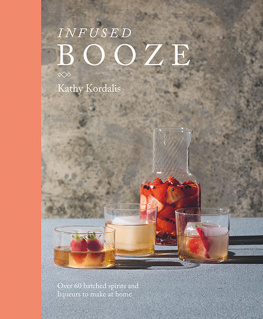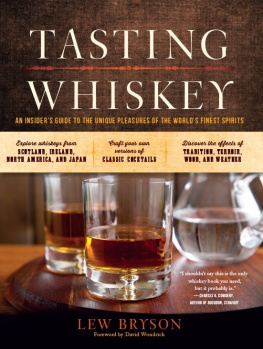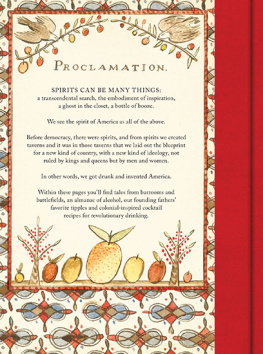CONTENTS
A re you the kind of person who goes off recipe when cooking a big meal? Do you ever sit with a glass of bourbon mentally devising the different ways you can take this wonderful drink and make it even better? If youre a risk-taker who likes to dabble, invent, experiment, and concoct (especially when it comes to your alcoholic beverages), youve come to the right place! This book guides you step by step through the process of creating unique and delicious alcoholic infusions and blends as well as infused cordials and crmesall with simple ingredients and all within the confines of your home. You dont need a special degree or fancy equipment, just this book and a propensity for trying something new.
Take care to choose your ingredients wisely. The farm-to-table world we live in today is brimming with opportunities to pair fresh, local ingredients from farmers markets and local outlets with spirits. Concurrently we enjoy the benefit of a global economy of trade, giving us the ability to source far-off fixings. With these two tools one can create some truly stunning concoctions. When purchasing fruits and vegetables for infusions, the closer to home it is grown, generally the better and fresher tasting. When seeking exotic ingredients the Internet can provide just about any herb or spice one can imagine. This handbook should be used for inspiration, but the sky truly is the limit when pairing your ingredients. Herein lies both a collection of somewhat simple recipes for the beginner as well as some more advanced infusions and cocktails from some of todays leading mixologists. Whatever flavors suit your palette, The Home Distilling & Infusing Handbook is here to get you started.
The craft of distillation holds within it both a winding history and a modern, pioneering spirit. For centuries the human race has found wonder and respite in a glass of hooch. From large mass-producers to the moonshine farmers and all the small-batch producers in between, today our planet yields a vast collection of alcoholic tinctures. The variety is bountiful thanks to our global trade routesmoving harvests of grain, fruit, spices, and botanicalsand the numerous crafting options available to the apt distiller. Credit must also be placed on the recent surge of small-batch distilleries opening their doors on a global scale.
This book is full of infusion recipes for the home distiller: a distiller limited in his or her licit options. Some claim infusion is a form a distillation, while others stand opposite. Nevertheless, the infusion process, for a master distiller, is but one tool resting on the tip of their bibulous paintbrush. For many spirits such as gin and flavored vodkas, macerating (or infusing) herbs, fruits, and other botanicals may play a key role in a labels creation. Some gin makers, for example, soak juniper berries or other botanicals in the base alcohol before succeeding rounds through the still take place. Even though you may not be able to build a still and go into business producing whiskey, it may be helpful to have a general understanding of common distilling methods and techniques. Understanding the thought that some producers put into creating the most pure neutral spirit leaves one with an appreciation for choosing an infusion base wiselyand an appreciation for using locally sourced farm-fresh ingredients when infusing at home.

THE LAW
 Laws governing home distilling are very strict and are markedly different state by state. Check your local and state laws.
Laws governing home distilling are very strict and are markedly different state by state. Check your local and state laws.
 There are no laws against making infusions or home vatting, providing you use spirits purchased from retailers, wholesalers, or producers.
There are no laws against making infusions or home vatting, providing you use spirits purchased from retailers, wholesalers, or producers.
 You are not allowed to sell the blends and infusions you create. Homemade spirits and blends make terrific gifts and party favors, though.
You are not allowed to sell the blends and infusions you create. Homemade spirits and blends make terrific gifts and party favors, though.
 This book contains many resources and makes various recommendations, not all of which are legal in all areas of the United States and abroad. Please take it upon yourself to know the laws in your region.
This book contains many resources and makes various recommendations, not all of which are legal in all areas of the United States and abroad. Please take it upon yourself to know the laws in your region.
ABC Crackdown in San Francisco
Recently, one of the hotbeds of infusions has been San Francisco. Some truly innovative creations were being offered at numerous bars in the area. The ABC, or the Alcoholic Beverage Commission, in California has ruled that bars making their own infusions are in fact breaking the law by altering liquor and selling it. Bars have been required to stop infusing. If you live in California, please contact your representative to put an end to this crackdown.
SAFETY
 When making cordials and crmes, do not add sugar to any liquor with less than 18 percent alcohol. The yeast will eat up the sugar creating carbon dioxide. This creates carbonation and can cause the bottles to explode.
When making cordials and crmes, do not add sugar to any liquor with less than 18 percent alcohol. The yeast will eat up the sugar creating carbon dioxide. This creates carbonation and can cause the bottles to explode.
 Be aware of the containers you use for making your infusions. You do not want to use plastic bottles or jugs or old leaded crystal jars as they can transfer their chemical taste into your liquid. These containers can impart an unpleasant taste into your infusion and even dangerous chemicals (especially with the lead). Also, do not use any containers that have stored anything except other liquors or foods, as residue can corrupt the purity of the taste.
Be aware of the containers you use for making your infusions. You do not want to use plastic bottles or jugs or old leaded crystal jars as they can transfer their chemical taste into your liquid. These containers can impart an unpleasant taste into your infusion and even dangerous chemicals (especially with the lead). Also, do not use any containers that have stored anything except other liquors or foods, as residue can corrupt the purity of the taste.
 Refrigerate any liqueurs or crmes you make that contain dairy products.
Refrigerate any liqueurs or crmes you make that contain dairy products.

I n its simplest from, as defined by Merriam-Webster, distillation is: the process of purifying a liquid by successive evaporation and condensation . Ancient alchemists discovered that by heating up a liquid made from fermented grains, fruits, or vegetablesall containing two key components: yeast and carbohydratesthey were able to separate the ethanol and then cool and collect it in a separate vessel. The key to distillation is that water evaporates at a temperature of 100 degrees Celsius while the ethanol turns to vapor first at 78.3 degrees. Control the heating element so that only the ethanol is boiling and we have the birth of the spirit!
Since then, technology and methodology have come a long way. The art of distillation has evolved into a process that employs countless variables and unending outcomes. From the water source of a vodka to the barrels used to age whiskeys, every variable counts.
Distilling is a science. It is a science with no exact cure and no unanimously procured perfection. Each distillers methodology is unique as is each sippers pallet. Each distiller mustin their own location and practicecreate or purchase neutral source spirit, select added ingredients, select what still they will use, and choose their distillation methods.











 Laws governing home distilling are very strict and are markedly different state by state. Check your local and state laws.
Laws governing home distilling are very strict and are markedly different state by state. Check your local and state laws.
